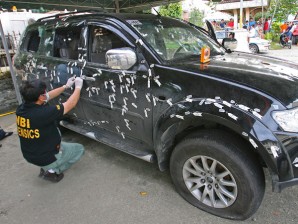
A member of the NBI fornensic team examines one of the bullet riddled SUV at the Municipal Police Station in Atimonan, Quezon where 13 people were killed in an alleged ‘shootout’ with police and military at a checkpoint last January 6.INQUIRER FILE PHOTO/RAFFY LERMA
CAMP VICENTE LIM, Laguna, Philippines — A checkpoint meant for arrests, not an ambush.
This was how Superintendent Hansel Marantan described the design of the police roadblock set up in Atimonan town in Quezon, to intercept an alleged criminal group along the national highway on Jan. 6 in dispelling reports that its members were summarily executed.
“If it were an ambush, four to five [operatives] are enough,” said Marantan, a high-ranking intelligence officer who led the ground operation that resulted in the deaths of Victor “Vic” Siman, alleged leader of the group, and 12 others, including three police officers and two Air Force soldiers.
Asked how that was possible, he said: “[Shoot] the driver, so that they could no longer proceed. And then you leave [after shooting everyone].”
The Philippine Daily Inquirer interviewed Marantan on Tuesday at St. Luke’s Medical Center in Taguig City while recuperating from bullet wounds he suffered in Atimonan. The police officer was the one who designed “Coplan (case operation plan) Armado,” which targeted Siman, who allegedly led a gambling and gunrunning syndicate.
He said he needed a “rapid deployment team” of the Army to set up the checkpoint in Atimonan and provide support. “Our intention was to arrest a group of 15-20 fully armed men,” he said.
The operating team was composed of 40 policemen and members of the Army’s Special Forces.
In Manila, an Inquirer source familiar with the military’s fact-finding investigation into the unit’s participation said on Tuesday that the soldiers, led by Lt. Col. Monico Abang, were at the checkpoint for barely 20 minutes when the supposed fire fight erupted at 3:30 p.m.
The source requested anonymity because he was not authorized to speak to reporters.
According to Abang, he received the call for assistance from Supt. Ramon Balauag, Quezon police intelligence chief, at around 11:30 a.m.
Calls for augmentation forces between the military and the police have already been the norm, Col. Generoso Bolina, spokesperson of the Army’s Southern Luzon Command, told reporters.
“There are times when the calls come first and the documents that formalize the augmentation come later because of the urgency of the operation,” Bolina said.
While Bolina said Abang was not informed that the target was Siman, the Inquirer source said that the battalion commander was told that it was Siman the police were after because he was part of a gun-for-hire group.
“There was no mention that Siman was an alleged ‘jueteng’ lord,” the source said.
The source said that in investigating the Atimonan incident, one should recognize the basic difference between the military and police doctrines in dealing with armed enemies.
“When soldiers are fired upon, they are trained to neutralize the enemy by forcing them to surrender through overwhelming firepower, or what we call volume of fire or sustained fire. In the course of this sustained fire, the enemy either surrenders or dies,” the source said.
“With law enforcement, the police doctrine is: You immobilize the enemy,” the source said. “Of course, you can’t just change the military doctrine to suit a police operation,” he added.